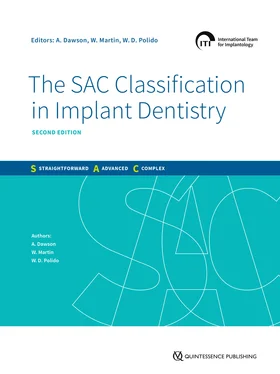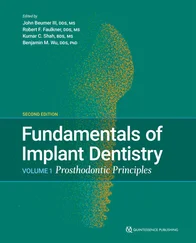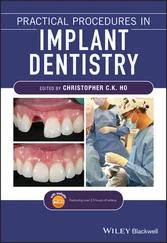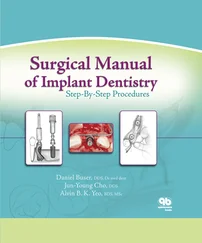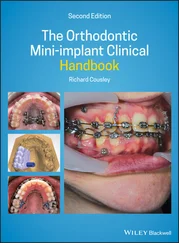Center for Implant Dentistry
Department of Oral and Maxillofacial Surgery
College of Dentistry
University of Florida
1395 Center Drive, Rm D7-6
Gainesville, Florida 32610
United States of America
Email: wmartin@dental.ufl.edu
Waldemar D. Polido, DDS, MS, PhD
Clinical Professor, Department of Oral and
Maxillofacial Surgery and Hospital Dentistry
Co-Director, Center for Implant, Esthetic and
Innovative Dentistry
Indiana University School of Dentistry
1121 W Michigan St, DS 109C
Indianapolis, Indiana 46202
United States of America
Email: wdpolido@iu.edu
Daniel Buser, DMD, Dr med dent
Professor Emeritus
University of Bern
Buser & Frei Center for Implantology
Werkgasse 2
3018 Bern
Switzerland
Email: danbuser@mac.com
Paolo Casentini, DDS, DMD
Private practice
Studio Dr Paolo Casentini
(Implantology, Oral Surgery, Periodontology, Esthetic Dentistry)
Via Anco Marzio 2
20123 Milano MI
Italy
Email: paolocasentini@fastwebnet.it
Vivianne Chappuis, PhD, DMD
Professor
Department of Oral Surgery and Stomatology
School of Dental Medicine
University of Bern
Freiburgstrasse 7
3010 Bern
Switzerland
Email: vivianne.chappuis@zmk.unibe.ch
Stephen Chen, MDSc, PhD
Faculty of Medicine, Dentistry and Health Sciences
Melbourne Dental School
The University of Melbourne
720 Swanston Street
Carlton, Victoria 3053
Australia
Email: schen@periomelbourne.com.au
Matteo Chiapasco, MD
Professor Unit of Oral Surgery
Department of Biomedical, Surgical, and Dental Sciences
University of Milan
Via della Commenda 10
20122 Milano MI
Italy
Email: matteo.chiapasco@unimi.it
Anthony J. Dickinson, OAM, BDSc, MSD, FRACDS
1564 Malvern Road
Glen Iris, Victoria 3146
Australia
Email: ajd1@i-pros.com.au
Luiz H. Gonzaga, DDS, MS
Clinical Associate Professor
Center for Implant Dentistry
Department of Oral and Maxillofacial Surgery
College of Dentistry
University of Florida
1395 Center Drive, Rm D7-6
Gainesville, Florida 32610-0434
United States of America
Email: lgonzaga@dental.ufl.edu
Stefan Keller Babotai, Dr sc nat
FERN Media Solutions GmbH
Weiherallee 11B
8610 Uster
Switzerland
Email: stefan.keller@fern.ch
Johannes Kleinheinz, MD, DDS Professor
Department of Cranio-Maxillofacial Surgery
University Hospital Münster
Albert-Schweitzer-Campus 1
48149 Münster
Germany
Email: johannes.kleinheinz@ukmuenster.de
Wei-Shao Lin, DDS, FACP, PhD
Associate Professor
Interim Chair, Department of Prosthodontics
Program Director, Advanced Education Program in Prosthodontics
Indiana University School of Dentistry
1121 W Michigan St, DS-S406
Indianapolis, Indiana 46202
United States of America
Email: weislin@iu.edu
Dean Morton, BDS, MS, FACP
Professor Department of Prosthodontics
Director, Center for Implant, Esthetic, and Innovative Dentistry
Indiana University School of Dentistry
1121 W Michigan St
Indianapolis, Indiana 46202
United States of America
Email: deamorto@iu.edu
Ali Murat Kökat, DDS, PhD
Prosthodontist
Private Practice
Valikonaǧı St 159/5
Nisantasi 34363 Sisli
Istanbul
Turkey
Email: alimurat@outlook.com
Mario Roccuzzo, DMD
Lecturer in Periodontology
Division of Maxillofacial Surgery
University of Turin
Corso Bramante 88
10126 Torino
Italy
and
Adjunct Clinical Assistant Professor
Department of Periodontics and Oral Medicine
University of Michigan
1011 N University Avenue
Ann Arbor, Michigan 48109-1078
United States of America
and
Private Practice Limited to Periodontology
Corso Tassoni 14
10143 Torino
Italy
Email: mroccuzzo@icloud.com
Charlotte Stilwell, DDS
Specialist Dental Services
94 Harley Street
London W1G 7HX
United Kingdom
Email: charlotte.stilwell@iti.org
Alejandro Treviño Santos, DDS, MSc
Postdoctoral and Research Division
Faculty of Dentistry
Department of Prosthodontics and Implantology
National Autonomous University of Mexico
Prolongación Reforma 1190
05349, Santa Fe
Ciudad de México
Mexico
Email: aletresan@hotmail.com
Daniel Wismeijer, PhD, DMD
Private Practice
Zutphensestraatweg 26
6955 AH Ellecom
Netherlands
Email: Danwismeijer@gmail.com
Chapter 1: Introduction to the Updated SAC Classification CHAPTER 1: Introduction to the Updated SAC Classification A. DAWSON, W. MARTIN, W. D. POLIDO
A. DAWSON, W. MARTIN, W. D. POLIDO
1.1 Introduction 1.1 Introduction Implant dentistry is an integral part of modern dental practice, providing a strong evidence-based option for the rehabilitation of partially and completely edentulous patients. Clinical and technologic advancements in this field have increased the level of confidence that clinicians have in this form of therapy and have also led to a broader base of incorporation into daily practice. What was once the domain of specialist practice is now a common treatment modality in many, if not most, general practices. This has increased the need for all clinicians involved with the field of implant dentistry, irrespective of specialty, to be able to provide therapy at an appropriate level of care. It has long been recognized that clinical situations present with different levels of difficulty and with different degrees of risk for esthetic, restorative, and surgical complications. Despite the advances in knowledge and improved techniques, implant dentistry is not free from risks of complications or suboptimal outcomes. Over the last decade, research in this field has increasingly provided information regarding the risks associated with this treatment option. The successful osseointegration of an implant is no longer the primary focus of treatment. Rather, the range of potential problems with implants and their related prostheses has come into sharper focus. It is in this environment that the SAC classification has evolved to assist practitioners in recognizing risk factors and providing appropriate levels of care.
1.2 Historical Background
1.3 The Review Team
1.4 Potential Roles for the SAC Classification
1.5 Using this Book
Chapter 2: The Rationale Behind the Updated SAC Classification
A. DAWSON, C. STILWELL
2.1 Definitions
2.2 Assumptions
2.3 Is the Clinician a Risk Factor?
2.3.1 Factors impacting the clinician as a risk factor
2.3.1.1 Experience
2.3.1.2 Training
2.3.1.3 Self-assessment of ability
2.3.1.4 Shared learning
2.3.1.5 Short training courses
2.3.1.6 Structured education and training
2.3.2 Reducing clinician-related risk
2.3.2.1 Recognizing “human factor” risks
2.3.2.2 Stress as a risk factor
2.3.2.3 Mitigating the human factor issues
2.3.2.4 Clinician risk factor in relation to other sources of risks
2.4 Classification Rationale
Chapter 3: Risks in Implant Dentistry
A. DAWSON, W. MARTIN, W. D. POLIDO
3.1 Principles of Risk Management
3.2 The SAC Classification as a Risk Management Tool
3.3 General Risks
A. DAWSON, J. KLEINHEINZ, A. MURAT KÖKAT, D. WISMEIJER
3.3.1 Patient medical factors
Читать дальше
